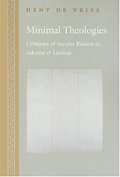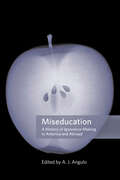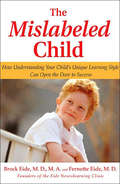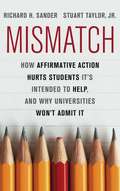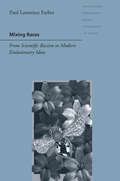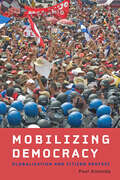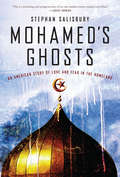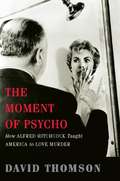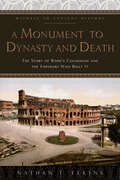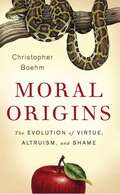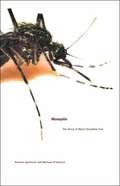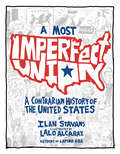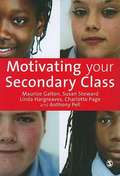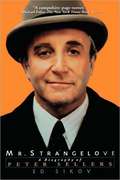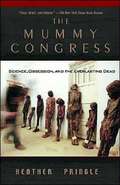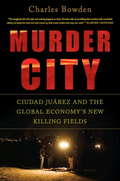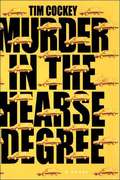- Table View
- List View
Minimal Theologies: Critiques of Secular Reason in Adorno and Levinas
by Hent de VriesWhat, at this historical moment "after Auschwitz," still remains of the questions traditionally asked by theology? What now is theology's minimal degree? This magisterial study, the first extended comparison of the writings of Theodor W. Adorno and Emmanuel Levinas, explores remnants and echoes of religious forms in these thinkers' critiques of secular reason, finding in the work of both a "theology in pianissimo" constituted by the trace of a transcendent other. The author analyzes, systematizes, and formalizes this idea of an other of reason. In addition, he frames these thinkers' innovative projects within the arguments of such intellectual heirs as Jürgen Habermas and Jacques Derrida, defending their work against later accusations of "performative contradiction" (by Habermas) or "empiricism" (by Derrida) and in the process casting important new light on those later writers as well. Attentive to rhetorical and rational features of Adorno's and Levinas's texts, his investigations of the concepts of history, subjectivity, and language in their writings provide a radical interpretation of their paradoxical modes of thought and reveal remarkable and hitherto unsuspected parallels between their philosophical methods, parallels that amount to a plausible way of overcoming certain impasses in contemporary philosophical thinking. In Adorno, this takes the form of a dialectical critique of dialectics; in Levinas, that of a phenomenological critique of phenomenology, each of which sheds new light on ancient and modern questions of metaphysics, ethics, and aesthetics. For the English-language publication, the author has extensively revised and updated the prize-winning German version.
Minimal Theologies: Critiques of Secular Reason in Adorno and Levinas
by Hent de VriesWhat, at this historical moment "after Auschwitz," still remains of the questions traditionally asked by theology? What now is theology's minimal degree? This magisterial study, the first extended comparison of the writings of Theodor W. Adorno and Emmanuel Levinas, explores remnants and echoes of religious forms in these thinkers' critiques of secular reason, finding in the work of both a "theology in pianissimo" constituted by the trace of a transcendent other. The author analyzes, systematizes, and formalizes this idea of an other of reason. In addition, he frames these thinkers' innovative projects within the arguments of such intellectual heirs as Jürgen Habermas and Jacques Derrida, defending their work against later accusations of "performative contradiction" (by Habermas) or "empiricism" (by Derrida) and in the process casting important new light on those later writers as well. Attentive to rhetorical and rational features of Adorno's and Levinas's texts, his investigations of the concepts of history, subjectivity, and language in their writings provide a radical interpretation of their paradoxical modes of thought and reveal remarkable and hitherto unsuspected parallels between their philosophical methods, parallels that amount to a plausible way of overcoming certain impasses in contemporary philosophical thinking. In Adorno, this takes the form of a dialectical critique of dialectics; in Levinas, that of a phenomenological critique of phenomenology, each of which sheds new light on ancient and modern questions of metaphysics, ethics, and aesthetics. For the English-language publication, the author has extensively revised and updated the prize-winning German version.
Miseducation: A History of Ignorance-Making in America and Abroad
by A. J. AnguloIgnorance, or the study of ignorance, is having a moment. Ignorance plays a powerful role in shaping public opinion, channeling our politics, and even directing scholarly research. The first collection of essays to grapple with the historical interplay between education and ignorance, Miseducation finds ignoranceâ€�and its social production through naïveté, passivity, and active agencyâ€�at the center of many pivotal historical developments. Ignorance allowed Americans to maintain the institution of slavery, Nazis to promote ideas of race that fomented genocide in the 1930s, and tobacco companies to downplay the dangers of cigarettes. Today, ignorance enables some to deny the fossil record and others to ignore climate science. A. J. Angulo brings together seventeen experts from across the scholarly spectrum to explore how intentional ignorance seeps into formal education. Each chapter identifies education as a critical site for advancing our still-limited understanding of what exactly ignorance is, where it comes from, and how it is diffused, maintained, and regulated in society.Miseducation also challenges the notion that schools are, ideally, unimpeachable sites of knowledge production, access, and equity. By investigating how laws, myths, national aspirations, and global relations have recast and, at times, distorted the key purposes of education, this pathbreaking book sheds light on the role of ignorance in shaping ideas, public opinion, and policy.
Miseducation: A History of Ignorance-Making in America and Abroad
by A. J. AnguloIgnorance, or the study of ignorance, is having a moment. Ignorance plays a powerful role in shaping public opinion, channeling our politics, and even directing scholarly research. The first collection of essays to grapple with the historical interplay between education and ignorance, Miseducation finds ignoranceâ€�and its social production through naïveté, passivity, and active agencyâ€�at the center of many pivotal historical developments. Ignorance allowed Americans to maintain the institution of slavery, Nazis to promote ideas of race that fomented genocide in the 1930s, and tobacco companies to downplay the dangers of cigarettes. Today, ignorance enables some to deny the fossil record and others to ignore climate science. A. J. Angulo brings together seventeen experts from across the scholarly spectrum to explore how intentional ignorance seeps into formal education. Each chapter identifies education as a critical site for advancing our still-limited understanding of what exactly ignorance is, where it comes from, and how it is diffused, maintained, and regulated in society.Miseducation also challenges the notion that schools are, ideally, unimpeachable sites of knowledge production, access, and equity. By investigating how laws, myths, national aspirations, and global relations have recast and, at times, distorted the key purposes of education, this pathbreaking book sheds light on the role of ignorance in shaping ideas, public opinion, and policy.
The Mislabeled Child: How Understanding Your Child's Unique Learning Style Can Open the Door to Success
by Brock Eide Fernette EideAn incredibly reassuring approach by two physicians who specialize in helping children overcome their difficulties in learning and succeeding in schoolFor parents, teachers, and other professionals seeking practical guidance about ways to help children with learning problems, this book provides a comprehensive look at learning differences ranging from dyslexia to dysgraphia, to attention problems, to giftedness. In The Mislabeled Child, the authors describe how a proper understanding of a child's unique brain-based strengths can be used to overcome many different obstacles to learning. They show how children are often mislabeled with diagnoses that are too broad (ADHD, for instance) or are simply inaccurate. They also explain why medications are often not the best ways to help children who are struggling to learn. The authors guide readers through the morass of commonly used labels and treatments, offering specific suggestions that can be used to help children at school and at home. This book offers extremely empowering information for parents and professionals alike.The Mislabeled Child examines a full spectrum of learning disorders, from dyslexia to giftedness, clarifying the diagnoses and providing resources to help. The Eides explain how a learning disability encompasses more than a behavioral problem; it is also a brain dysfunction that should be treated differently.
The Mislabeled Child: How Understanding Your Child's Unique Learning Style Can Open the Door to Success
by Brock Eide Fernette EideAn incredibly reassuring approach by two physicians who specialize in helping children overcome their difficulties in learning and succeeding in school For parents, teachers, and other professionals seeking practical guidance about ways to help children with learning problems, this book provides a comprehensive look at learning differences ranging from dyslexia to dysgraphia, to attention problems, to giftedness. In The Mislabeled Child, the authors describe how a proper understanding of a child's unique brain-based strengths can be used to overcome many different obstacles to learning. They show how children are often mislabeled with diagnoses that are too broad (ADHD, for instance) or are simply inaccurate. They also explain why medications are often not the best ways to help children who are struggling to learn. The authors guide readers through the morass of commonly used labels and treatments, offering specific suggestions that can be used to help children at school and at home. This book offers extremely empowering information for parents and professionals alike.The Mislabeled Child examines a full spectrum of learning disorders, from dyslexia to giftedness, clarifying the diagnoses and providing resources to help. The Eides explain how a learning disability encompasses more than a behavioral problem; it is also a brain dysfunction that should be treated differently.
Mismatch: How Affirmative Action Hurts Students It's Intended to Help, and Why Universities Won't Admit It
by Richard Sander Stuart Taylor Jr.Affirmative action in higher education started in the late 1960s as a noble effort to jump-start racial integration in American society and create the conditions for genuine equal opportunity. Forty years later, it has evolved into a swampland of posturing, concealment, pork-barrel set-asides, and—worst of all—a preferences system so blind to its own shortcomings that it ends up hurting the very minorities educators set out to help.Over the past several years, economist, law professor and civil rights activist Richard Sander has led a national consortium of more than two dozen nonpartisan scholars to study the operation and effects of preferences in higher education. In Mismatch, he and journalist Stuart Taylor present a rich and data-driven picture of the way affirmative action works (and doesn&’t work) in this setting.Though their liberal leanings would indicate support for race-based policies, Sander and Taylor argue that the research shows that affirmative action does not in fact help minorities. Racial preferences in higher education put a great many students in educational settings where they have no hope of competing—a phenomenon that they call &“mismatch.&” American law schools provide a particularly vivid illustration of how &“mismatch&” harms the educations and careers of many minority students. Compelling evidence shows that racial preferences double the rate at which black students fail bar exams and may well in the end reduce, rather than increase, the aggregate number of black lawyers.Moreover, because preferences are targeted at upper-middle class minorities, they help shut low-income students of all races out of much of higher education. If you&’re black and poor—or white and poor, for that matter—your chances of stepping into the halls of some of the nation&’s most elite institutions are no greater than they were in the 1960s. Unfortunately, the academic establishment is only committed to symbolic change, and it will undermine any research that contests its reflexive political correctness and challenges its sacred cows. Sander and Taylor argue that university leaders and much of America&’s elite have become so deeply committed to an ideology of racial preferences, and so distrustful of broader American public opinion on these issues, that they have widely embraced regimes that ignore the law, hide data, and put out systematic misinformation on their own racial policies.Sander and Taylor conclude by looking at data on how to level the racial playing field in higher education. Existing studies, they argue, suggest that early childhood interventions are much more likely to produce success down the line.
Mixing Races: From Scientific Racism to Modern Evolutionary Ideas (Johns Hopkins Introductory Studies in the History of Science)
by Paul Lawrence FarberThis book explores changing American views of race mixing in the twentieth century, showing how new scientific ideas transformed accepted notions of race and how those ideas played out on college campuses in the 1960s.In the 1930s it was not unusual for medical experts to caution against miscegenation, or race mixing, espousing the common opinion that it would produce biologically dysfunctional offspring. By the 1960s the scientific community roundly refuted this theory. Paul Lawrence Farber traces this revolutionary shift in scientific thought, explaining how developments in modern population biology, genetics, and anthropology proved that opposition to race mixing was a social prejudice with no justification in scientific knowledge.In the 1960s, this new knowledge helped to change attitudes toward race and discrimination, especially among college students. Their embrace of social integration caused tension on campuses across the country. Students rebelled against administrative interference in their private lives, and university regulations against interracial dating became a flashpoint in the campus revolts that revolutionized American educational institutions. Farber’s provocative study is a personal one, featuring interviews with mixed-race couples and stories from the author’s student years at the University of Pittsburgh. As such, Mixing Races offers a unique perspective on how contentious debates taking place on college campuses reflected radical shifts in race relations in the larger society.
Mobilizing Democracy: Globalization and Citizen Protest (Themes in Global Social Change)
by Paul AlmeidaPaul Almeida’s comparative study of the largest social movement campaigns that existed between 1980 and 2013 in every Central American country (Costa Rica, El Salvador, Guatemala, Honduras, Nicaragua, and Panama) provides a granular examination of the forces that spark mass mobilizations against state economic policy, whether those factors are electricity rate hikes or water and health care privatization. Many scholars have explained connections between global economic changes and local economic conditions, but most of the research has remained at the macro level. Mobilizing Democracy contributes to our knowledge about the protest groups "on the ground" and what makes some localities successful at mobilizing and others less successful. His work enhances our understanding of what ingredients contribute to effective protest movements as well as how multiple protagonistsâ€�labor unions, students, teachers, indigenous groups, nongovernmental organizations, women’s groups, environmental organizations, and oppositional political partiesâ€�coalesce to make protest more likely to win major concessions.Based on extensive field research, archival data of thousands of protest events, and interviews with dozens of Central American activists, Mobilizing Democracy brings the international consequences of privatization, trade liberalization, and welfare-state downsizing in the global South into focus and shows how persistent activism and network building are reactivated in these social movements. Almeida enables our comprehension of global and local politics and policy by answering the question, "If all politics is local, then how do the politics of globalization manifest themselves?" Detailed graphs and maps provide a synthesis of the quantitative and qualitative data in this important study. Written in clear, accessible prose, this book will be invaluable for students and scholars in the fields of political science, social movements, anthropology, Latin American studies, and labor studies.
Mohamed's Ghosts: An American Story of Love and Fear in the Homeland
by Stephan SalisburyMohamed Ghorab had no hint one late spring morning in May 2004 that when he dropped his daughter off at school, his life would change forever. Federal agents and police surrounded him in front of terrified parents, teachers, and school children. They hustled him off to jail and eventually deported him. His wife, bewildered and astonished,was detained at the same time,. Moments later, agents raided the obscure Philadelphia mosque where Ghorab was imam, ransacking its simple interior and his house next door. Over the next several months, members of Ghorab&’s congregation would be arrested and detained, interrogated and watched. Many would be deported. Others would flee the neighborhood and the country as their lives became riddled with rumor. Informants seemed to be listening everywhere. Husbands were separated from wives. Children were torn from parents. The mosque collapsed in a sea of debt and anxiety. The neighborhood lost something essential--trust and community. This was a jumpy and fearful time in the life of America following 9/11, as prize-winning reporter Stephan Salisbury well knew. But he did not anticipate the extremity of fear that emerged as he explored the aftermath of that virtually forgotten raid. Over time, the members of the mosque and the imam&’s family gradually opened up to him, giving Salisbury a unique opportunity to chronicle the demolition of lives and families, the spread of anti-immigrant hysteria, and its manipulation by the government. As he explores events centered on what he calls &“the poor streets of Frankford Valley&” in Philadelphia, or the empty streets of Brooklyn , or the fear-encrusted precincts of Lodi, California and beyond, Salisbury is constantly reminded of similar incidents in his own past--the paranoia and police activity that surrounded his political involvement in the 1960s, and the surveillance and informing that dogged his father, a well-known New York Times reporter and editor, for half a century. Salisbury weaves these strands together into a personal portrait of an America fracturing under the intense pressure of the war on terror--the Homeland in the time of Osama.
The Moment of Psycho: How Alfred Hitchcock Taught America to Love Murder
by David ThomsonIt was made like a television movie, and completed in less than three months. It killed off its star in forty minutes. There was no happy ending. And it offered the most violent scene to date in American film, punctuated by shrieking strings that seared the national consciousness. Nothing like Psycho had existed before; the movie industry—even America itself—would never be the same.In The Moment of Psycho, film critic David Thomson situates Psycho in Alfred Hitchcock&’s career, recreating the mood and time when the seminal film erupted onto film screens worldwide. Thomson shows that Psycho was not just a sensation in film: it altered the very nature of our desires. Sex, violence, and horror took on new life. Psycho, all of a sudden, represented all America wanted from a film—and, as Thomson brilliantly demonstrates, still does.
The Moment of Psycho: How Alfred Hitchcock Taught America to Love Murder
by David ThomsonIt was made like a television movie, and completed in less than three months. It killed off its star in forty minutes. There was no happy ending. And it offered the most violent scene to date in American film, punctuated by shrieking strings that seared the national consciousness. Nothing like Psycho had existed before; the movie industry -- even America itself -- would never be the same. In The Moment of Psycho, film critic David Thomson situates Psycho in Alfred Hitchcock's career, recreating the mood and time when the seminal film erupted onto film screens worldwide. Thomson shows that Psycho was not just a sensation in film: it altered the very nature of our desires. Sex, violence, and horror took on new life. Psycho, all of a sudden, represented all America wanted from a film -- and, as Thomson brilliantly demonstrates, still does.
A Monument to Dynasty and Death: The Story of Rome's Colosseum and the Emperors Who Built It (Witness to Ancient History)
by Nathan T. ElkinsEarly one morning in 80 CE, the Colosseum roared to life with the deafening cheers of tens of thousands of spectators as the emperor, Titus, inaugurated the new amphitheater with one hundred days of bloody spectacles. These games were much anticipated, for the new amphitheater had been under construction for a decade. Home to spectacles involving exotic beasts, elaborate executions of criminals, gladiatorial combats, and even—when flooded—small-scale naval battles, the building itself was also a marvel. Rising to a height of approximately 15 stories and occupying an area of 6 acres—more than four times the size of a modern football field—the Colosseum was the largest of all amphitheaters in the Roman Empire. In A Monument to Dynasty and Death, Nathan T. Elkins tells the story of the Colosseum's construction under Vespasian, its dedication under Titus, and further enhancements added under Domitian. The Colosseum, Elkins argues, was far more than a lavish entertainment venue: it was an ideologically charged monument to the new dynasty, its aspirations, and its achievements. A Monument to Dynasty and Death takes readers on a behind-the-scenes tour of the Colosseum from the subterranean tunnels, where elevators and cages transported gladiators and animals to the blood-soaked arena floor, to the imperial viewing box, to the amphitheater's decoration and amenities, such as fountains and an awning to shade spectators. Trained as an archaeologist, an art historian, and a historian of ancient Rome, Elkins deploys an interdisciplinary approach that draws on contemporary historical texts, inscriptions, archaeology, and visual evidence to convey the layered ideological messages communicated by the Colosseum. This engaging book is an excellent resource for classes on Roman art, architecture, history, civilization, and sport and spectacle.
A Monument to Dynasty and Death: The Story of Rome's Colosseum and the Emperors Who Built It (Witness to Ancient History)
by Nathan T. ElkinsEarly one morning in 80 CE, the Colosseum roared to life with the deafening cheers of tens of thousands of spectators as the emperor, Titus, inaugurated the new amphitheater with one hundred days of bloody spectacles. These games were much anticipated, for the new amphitheater had been under construction for a decade. Home to spectacles involving exotic beasts, elaborate executions of criminals, gladiatorial combats, and even—when flooded—small-scale naval battles, the building itself was also a marvel. Rising to a height of approximately 15 stories and occupying an area of 6 acres—more than four times the size of a modern football field—the Colosseum was the largest of all amphitheaters in the Roman Empire. In A Monument to Dynasty and Death, Nathan T. Elkins tells the story of the Colosseum's construction under Vespasian, its dedication under Titus, and further enhancements added under Domitian. The Colosseum, Elkins argues, was far more than a lavish entertainment venue: it was an ideologically charged monument to the new dynasty, its aspirations, and its achievements. A Monument to Dynasty and Death takes readers on a behind-the-scenes tour of the Colosseum from the subterranean tunnels, where elevators and cages transported gladiators and animals to the blood-soaked arena floor, to the imperial viewing box, to the amphitheater's decoration and amenities, such as fountains and an awning to shade spectators. Trained as an archaeologist, an art historian, and a historian of ancient Rome, Elkins deploys an interdisciplinary approach that draws on contemporary historical texts, inscriptions, archaeology, and visual evidence to convey the layered ideological messages communicated by the Colosseum. This engaging book is an excellent resource for classes on Roman art, architecture, history, civilization, and sport and spectacle.
Moral Origins: The Evolution of Virtue, Altruism, and Shame
by Christopher BoehmFrom the age of Darwin to the present day, biologists have been grappling with the origins of our moral sense. Why, if the human instinct to survive and reproduce is "selfish," do people engage in self-sacrifice, and even develop ideas like virtue and shame to justify that altruism? Many theories have been put forth, some emphasizing the role of nepotism, others emphasizing the advantages of reciprocation or group selection effects. But evolutionary anthropologist Christopher Boehm finds existing explanations lacking, and in Moral Origins, he offers an elegant new theory.Tracing the development of altruism and group social control over 6 million years, Boehm argues that our moral sense is a sophisticated defense mechanism that enables individuals to survive and thrive in groups. One of the biggest risks of group living is the possibility of being punished for our misdeeds by those around us. Bullies, thieves, free-riders, and especially psychopaths--those who make it difficult for others to go about their lives--are the most likely to suffer this fate. Getting by requires getting along, and this social type of selection, Boehm shows, singles out altruists for survival. This selection pressure has been unique in shaping human nature, and it bred the first stirrings of conscience in the human species. Ultimately, it led to the fully developed sense of virtue and shame that we know today.A groundbreaking exploration of the evolution of human generosity and cooperation, Moral Origins offers profound insight into humanity's moral past--and how it might shape our moral future.
Moral Origins: The Evolution of Virtue, Altruism, and Shame
by Christopher BoehmFrom the age of Darwin to the present day, biologists have been grappling with the origins of our moral sense. Why, if the human instinct to survive and reproduce is "selfish," do people engage in self-sacrifice, and even develop ideas like virtue and shame to justify that altruism? Many theories have been put forth, some emphasizing the role of nepotism, others emphasizing the advantages of reciprocation or group selection effects. But evolutionary anthropologist Christopher Boehm finds existing explanations lacking, and in Moral Origins, he offers an elegant new theory. Tracing the development of altruism and group social control over 6 million years, Boehm argues that our moral sense is a sophisticated defense mechanism that enables individuals to survive and thrive in groups. One of the biggest risks of group living is the possibility of being punished for our misdeeds by those around us. Bullies, thieves, free-riders, and especially psychopaths -- those who make it difficult for others to go about their lives -- are the most likely to suffer this fate. Getting by requires getting along, and this social type of selection, Boehm shows, singles out altruists for survival. This selection pressure has been unique in shaping human nature, and it bred the first stirrings of conscience in the human species. Ultimately, it led to the fully developed sense of virtue and shame that we know today.A groundbreaking exploration of the evolution of human generosity and cooperation, Moral Origins offers profound insight into humanity's moral past -- and how it might shape our moral future.
Mosquito: The Story of Man's Deadliest Foe
by Andrew SpielmanNow in paperback--a fascinating work of popular science from a world-renowned expert on mosquitoes and a prize-winning reporter.In this lively and comprehensive portrait of the mosquito, its role in history, and its threat to mankind, Spielman and D'Antonio take a mosquito's-eye view of nature and man. They show us how mosquitoes breed, live, mate, and die, and introduce us to their enemies, both natural and man-made. The authors present tragic and often grotesque examples of how the mosquito has insinuated itself into human history, from the malaria that devastated invaders of ancient Rome to the current widespread West Nile fever panic. Filled with little-known facts and remarkable anecdotes that bring this tiny being into larger focus, Mosquito offers fascinating, alarming, and convincing evidence that the sooner we get to know this pesky insect, the better off we'll be.
Mosquito: The Story of Man's Deadliest Foe
by Andrew SpielmanNow in paperback--a fascinating work of popular science from a world-renowned expert on mosquitoes and a prize-winning reporter.In this lively and comprehensive portrait of the mosquito, its role in history, and its threat to mankind, Spielman and D'Antonio take a mosquito's-eye view of nature and man. They show us how mosquitoes breed, live, mate, and die, and introduce us to their enemies, both natural and man-made. The authors present tragic and often grotesque examples of how the mosquito has insinuated itself into human history, from the malaria that devastated invaders of ancient Rome to the current widespread West Nile fever panic. Filled with little-known facts and remarkable anecdotes that bring this tiny being into larger focus, Mosquito offers fascinating, alarming, and convincing evidence that the sooner we get to know this pesky insect, the better off we'll be.
A Most Imperfect Union: A Contrarian History of the United States
by Ilan StavansEnough with the dead white men! The true story of the United States lies with its most overlooked and marginalized peoples-the workers, immigrants, housewives, and slaves who built America from the ground up, and who made this country what it is today. In A Most Imperfect Union, cultural critic Ilan Stavans and award-winning cartoonist Lalo Alcaraz present a vibrant history of these unsung Americans. In an irreverent, fast-paced narrative that challenges the conventional narrative of American history, Stavans and Alcaraz offer a fresh, controversial take on the philosophies, products, practices, and people-from Algonquin and African royals to early feminists, Puerto Rican radicals, and Arab immigrants-that have made America such an outsized and extraordinary land.
Motivating Your Secondary Class (PDF)
by Maurice J Galton Susan StewardWhy do so many pupils in Years 7, 8 and 9 'switch off' and make very little progress in the core subjects such as English and mathematics? What can teachers and schools do to improve pupils' attitudes and motivation? Maurice Galton and his team have collected examples from various schools of what works in re-energising demotivated pupils. This book presents practical advice and strategies for improving lower secondary school classrooms, ranging from reducing class size, to innovative induction programmes emphasising the development of core study skills, and developing effective procedures to train pupils to cooperate rather than confront each other during lessons. Chapters cover: Making a Good Start to Secondary Education Creating a Cooperative Classroom Climate Improving Communication between Pupils and Teachers Why are some classrooms more successful? How can school structures influence positive relationships? nbsp; The book is a much-needed resource for all secondary teachers, and is particularly useful for year and subject heads. 9781847872593 9781446221099 9786612304729 9781849204330
Mr. Strangelove: A Biography of Peter Sellers
by Ed SikovPeter Sellers's explosive talent made him a beloved figure in world cinema and continues to attract new audiences. With his darkly comic performances in Dr. Strangelove and Lolita and his outrageously funny appearances as Inspector Clouseau in the Pink Panther films, he became one of the most popular movie stars of his time. Sellers himself identified most personally with the character he played in Being There--an utterly empty man on whom others projected what they wanted, or needed, to see. In this lively and exhaustively researched biography, Ed Sikov offers unique insight into Sellers's comedy style. Beginning with Sellers' lonely childhood with a mother who wouldn't let go of him, through his service in the Royal Air Force and his success on BBC Radio's The Goon Show, Sikov goes on to detail his relationships with co-stars such as Alec Guinness, Sophia Loren, and Shirley MacLaine; his work with such directors as Stanley Kubrick, Billy Wilder, and Blake Edwards; his four failed marriages; his ridiculously short engagement to Liza Minnelli; and all the other peculiarities of this eccentric man's unpredictable life. The most insightful biography ever written of this endlessly fascinating star, Mr. Strangelove is as comic and tragic as Peter Sellers was himself.
Mr. Strangelove: A Biography of Peter Sellers
by Ed SikovPeter Sellers's explosive talent made him a beloved figure in world cinema and continues to attract new audiences. With his darkly comic performances in Dr. Strangelove and Lolita and his outrageously funny appearances as Inspector Clouseau in the Pink Panther films, he became one of the most popular movie stars of his time. Sellers himself identified most personally with the character he played in Being There -- an utterly empty man on whom others projected what they wanted, or needed, to see. In this lively and exhaustively researched biography, Ed Sikov offers unique insight into Sellers's comedy style. Beginning with Sellers' lonely childhood with a mother who wouldn't let go of him, through his service in the Royal Air Force and his success on BBC Radio's The Goon Show, Sikov goes on to detail his relationships with co-stars such as Alec Guinness, Sophia Loren, and Shirley MacLaine; his work with such directors as Stanley Kubrick, Billy Wilder, and Blake Edwards; his four failed marriages; his ridiculously short engagement to Liza Minnelli; and all the other peculiarities of this eccentric man's unpredictable life. The most insightful biography ever written of this endlessly fascinating star, Mr. Strangelove is as comic and tragic as Peter Sellers was himself.
The Mummy Congress: Science, Obsession, and the Everlasting Dead
by Heather PringleMummies, experts, and breaking science revealed in journalist Pringle's fascinating dive into a little-known arena of human studies.Perhaps the most eccentric of all scientific meetings, the World Congress on Mummy Studies brings together mummy experts from all over the globe and airs their latest findings. Who are these scientists, and what draws them to this morbid yet captivating field? The Mummy Congress, written by acclaimed science journalist Heather Pringle, examines not just the world of mummies, but also the people obsessed with them.
Murder City: Ciudad Juarez and the Global Economy's New Killing Fields
by Charles Bowdenp.p1 {margin: 0.0px 0.0px 0.0px 0.0px; font: 11.0px Calibri} span.s1 {font-kerning: none} Ciudad Juarez lies just across the Rio Grande from El Paso, Texas. A once-thriving border town, it now resembles a failed state. Infamously known as the place where women disappear, its murder rate exceeds that of Baghdad.In Murder City, Charles Bowden-one of the few journalists who spent extended periods of time in Juarez-has written an extraordinary account of what happens when a city disintegrates. Interweaving stories of its inhabitants-a beauty queen who was raped, a repentant hitman, a journalist fleeing for his life-with a broader meditation on the town's descent into anarchy, Bowden reveals how Juarez's culture of violence will not only worsen, but inevitably spread north.Heartbreaking, disturbing, and unforgettable, Murder City was written at the height of his powers and established Bowden as one of America's leading journalists.
Murder in the Hearse Degree: A Novel (Sin Hunters Ser.)
by Tim CockeyLibby, a former flame of Hitchcock Sewell, has returned to town with her two children, but minus one husband and one nanny. Libby's husband has been accounted for--she left him back in Annapolis. However, the nanny, Sophie, is truly missing. As soon as Hitch starts to nose around, Sophie turns up--literally--in the Severn River. She's quite dead, and just a little bit pregnant. The police suspect suicide, but Sophie's mom is adamant it's murder. Hitch's sense: He sides with the mother. Racing around town, Hitch finds more questions than answers. Murder in the Hearse Degree is another pitch-perfect mystery in a series that never disappoints, always surprises, and keeps the laughs--and corpses--rolling right along.
